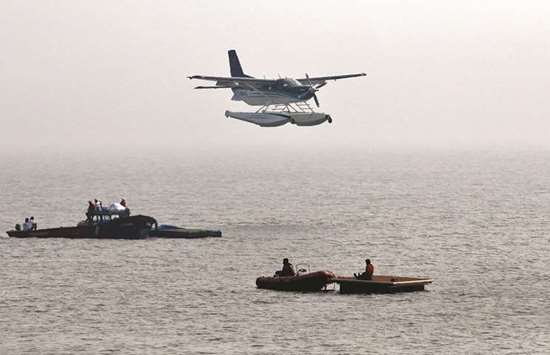It was the second phase of trials for the amphibious aircraft, the airline said in a statement.
In the first phase, trials were conducted in Nagpur and Guwahati.
The trials were conducted in the presence of federal Minister of Road Transport and Highways Nitin Gadkari and Aviation Minister Ashok Gajapathi Raju.
Gadkari said seaplanes will give a big push for regional connectivity.
The trails were conducted in association with Japan’s Setouchi Holdings, SpiceJet said, adding both “have been working closely for over six months to explore opportunities for small 10- and 14-seater amphibious and land plane operations” to provide air connectivity to smaller towns.
Setouchi Holding owns “QUEST”, the manufacturer of specialised amphibious and non-amphibious range of aircraft globally. There are about 200 Kodiak Quest aircraft flying all over the world for the past 10 years.
SpiceJet chief Ajay Singh said: “Seaplane operations can bring the remotest parts of India into the mainstream aviation network without the high cost of building airports and runways.
“While we are one of the fastest growing aviation markets in the world, we need to ensure equitable and inclusive air connectivity within the country. Our seaplane service will open a whole new market for both the airline and tourism industry and will revolutionise the regional connectivity scheme.
“Airports are in short supply in India,” Singh said. “Lots of the growth in India is happening in small markets, but those small markets have little or no connectivity. So we are looking for a solution where we can get flights to places where no airports exist.”
Prime Minister Narendra Modi unveiled a plan in 2015 to bring aviation to the remotest parts of the world’s seventh-biggest land mass. The government programme subsidises airfares while offering free landing and parking to airlines. Modi envisages domestic ticket sales quintupling in the next decade to half a billion units.
About 97% of India’s 1.3bn people have never been on an airplane, according to SpiceJet. But there’s a problem finding places to pick up and drop off those passengers.
Only about 75 of the 450 areas designated by the Indian government as an airport or airstrip currently handle commercial flights. That exacerbates the stress on major airports in New Delhi, Mumbai and Bengaluru, where hardly any landing slots are available.
Infrastructure at most of those dormant airports – runways, control towers, terminals and maintenance sheds – has suffered decades of neglect, making the sites unusable.
That’s where SpiceJet’s amphibious strategy comes in. The Kodiak aircraft is capable of taking off or landing on a 300m strip of water or land, and has a range of 1,000km. That’s about the distance between Mumbai and Bengaluru.
SpiceJet is the only Indian company so far to explore air connectivity through water bodies such as rivers and inland waterways.


